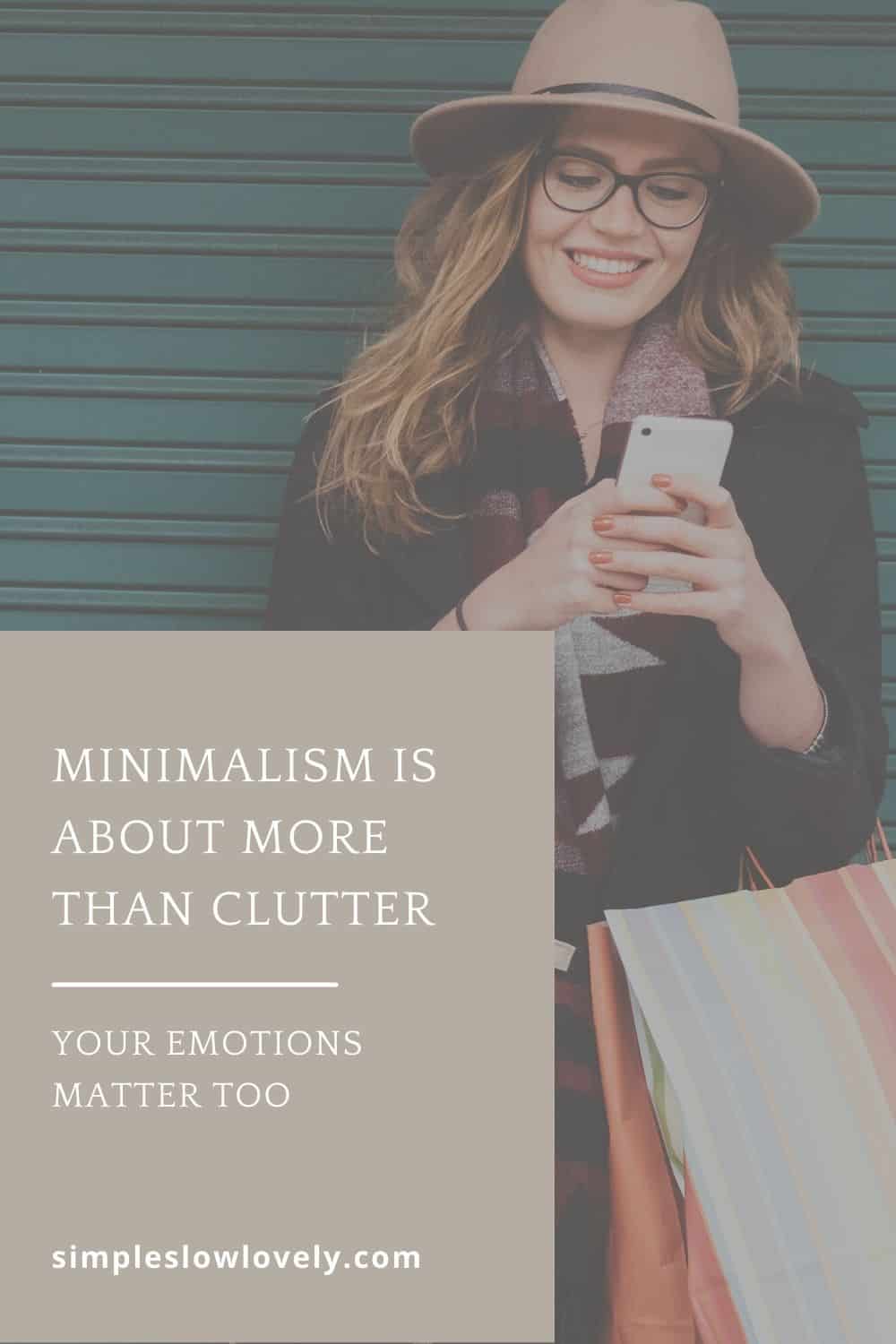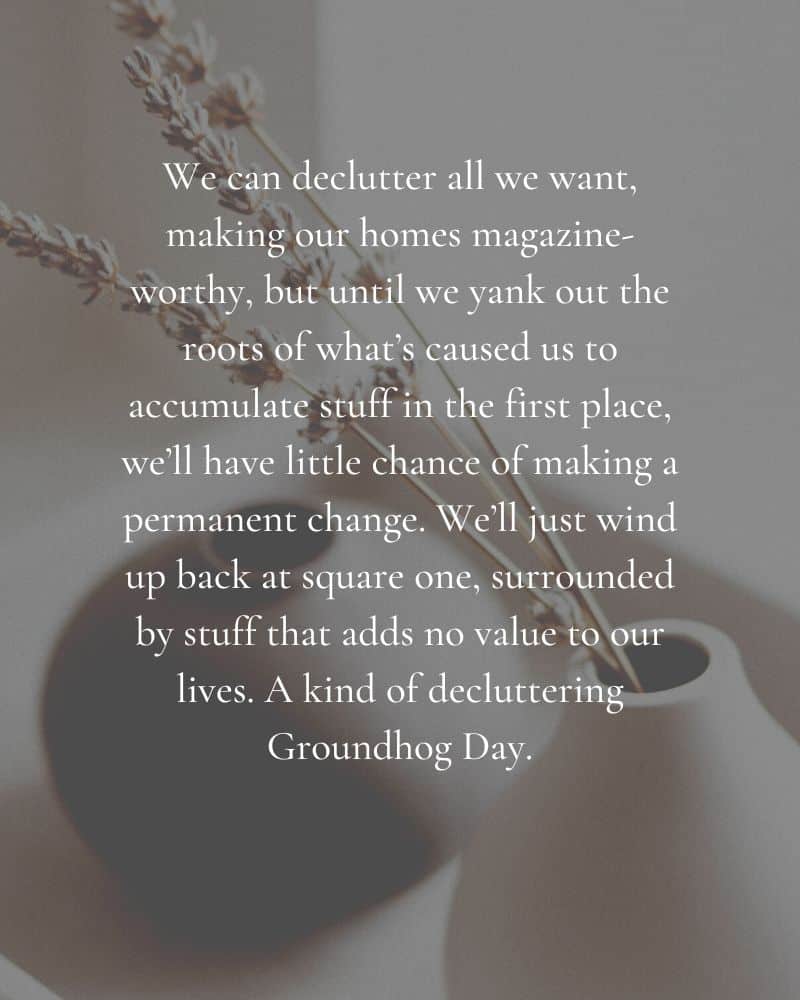Embarking on a decluttering and minimizing endeavour can be difficult. In fact, it can be downright scary at times. This is because minimalism isn’t just about your stuff—it’s also about your why. Why you accumulated so much in the first place. And this can be a difficult and emotional journey for anyone.
Once upon a time, I was a shopaholic. Uncomfortable in my own skin, I attempted to reclothe myself in whatever the latest fashion was, choosing clothes as a second skin to boost my confidence. In my early twenties, purchasing one or two new items of clothing a week was pretty normal.
And although I always felt great in a new outfit, the feeling never lasted. The temporary boost of confidence was just replaced by a bulging wardrobe. When I decided to minimize my possessions a few years ago the thought of working through these piles of clothing I’d accumulated was overwhelming.
Because it wasn’t just the clothes I had to sort through.
If I wanted to make a lasting change to a tidier, smaller wardrobe, I had to deal with why I’d accumulated so much in the first place. And as it turns out, my why was connected to my self-worth. The reason I found solace in shiny new things was that they made me feel accepted.
Acceptance of myself has never come easy and the lack of it stems from my start to life. Being given up for adoption at birth is something that has always tainted my worldview.
At the heart of many shopping trips was my limbic brain response to being given away. It was my inner baby, clawing at something, anything to prove my right to exist. If I looked good, I would be wanted, and not discarded.
Underneath our piles of belongings, we hide fears, loneliness, and insecurities. Behind a bulging wardrobe and piles of shoes, a fear of never being loved or even liked might be lurking. Beneath a pile of impulse homeware purchases, an overwhelming anxiety might be hiding.

Clutter and excess are rarely the root of a problem, they are the result. Even worse, the clutter compounds the problem, causing further stress and anxiety.
This is important to understand.
We can declutter all we want, making our homes magazine-worthy, but until we yank out the roots of what’s caused us to accumulate stuff in the first place, we’ll have little chance of making a permanent change. We’ll just wind up back at square one, surrounded by stuff that adds no value to our lives. A kind of decluttering Groundhog Day.
You can make a permanent change in your life, to minimize your belongings, but only if you deal with the roots.
Where does one start?
Identify Your Emotions
Begin by noticing what you feel when you reach for your credit card. Awareness of the driving forces behind these purchases is an important first step. It took me awhile to realize that I was trying to fill emotional spaces when I went shopping. But once I named the emotions, it became easier to forgo shopping trips.
It might take months of just noticing the reasons you accumulate before you feel ready to make changes. But when you do…
Engage With Your Emotions as You Declutter
At the heart of my bulging wardrobe was pain from feeling unworthy. I had to engage with this pain and move through it as I decluttered. This doesn’t mean that I still don’t feel the pain. But now that I’ve recognized this emotion as a trigger, I’m less likely to add to my wardrobe and find it easier to simplify.
What do you feel looking at your piles of belongings?
Do you feel anxious? Anxiety about what you might need in a hypothetical future will stop you in your decluttering tracks. People hold onto items ‘just in case’, thinking they won’t be able to afford to replace it if they need it again. This is where community toy and tool libraries can help. When our girls are done with their toys, I donate them rather than keeping them for the grandchildren. I know when that time arrives, I can visit the toy library instead of the attic.
Do you feel lonely? If your trigger to purchasing (or keeping) items is loneliness, try connecting with others. Many of us are surrounded by people but still feel incredibly alone. Make a phone call to someone whose voice you need to hear. Ask someone to join you on your daily walk or meet someone for coffee. Ironically, the upkeep of these piles of belongings is often what keeps us from making and keeping meaningful connection with others.
Do you feel stressed and overwhelmed? Some of us have lived decades without curating our possessions. In our never-ending busyness, we lack time and energy to spring clean, let alone declutter. Find a way to drop one or two things off your to-do list and calendar this week. Decluttering does take time, but you can find it if you’re intentional.

Take Care of Yourself
Whatever it is that’s hiding under your piles of clutter, tread carefully. Take the best care of yourself possible during this process. Take regular breaks to do things that fill you back up. It might be reading a book, taking a bath, or going for a long walk. These difficult emotions, the pain, the insecurities, the worry and the sadness, they need your tender loving care as you move them gently aside.
I’ve gone through several large purges of my possessions over the last few years. I’ve swept through my home twice, each time getting rid of over 500 items. And last year, when we prepared to rent our house out, I took several car loads to our recycling center. Each time, the process got easier. Each time, I’m a little more confident and a little less fearful of looking under the rug to check what’s hiding.
I’m inching my way towards a curated and intentional life with less of what I don’t need and more of what I want.
As I’ve become more aware of my insecurities and found other ways to cope with difficult emotions, it’s become easier to let go of things. I don’t need a new outfit for every occasion. I’m happy shopping at my local thrift shops and wearing well-worn favorites. I’ve survived the long-haul of decluttering because I’ve looked after myself in the process.
And my sum total of 6 pairs of shoes? Feels like one too many.
*This post was originally published on Becoming Minimalist on 11/6/2018.



